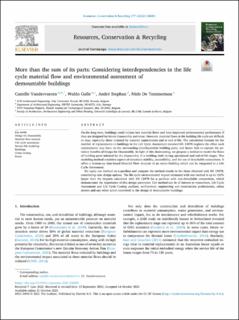| dc.description.abstract | On the long term, buildings could initiate less material flows and have improved environmental performance if they are designed for future disassembly and reuse. However, material flows in the building life cycle are difficult to map, especially those initiated by material replacements and at end-of-life. The calculation formula for the number of replacements in buildings in the Life Cycle Assessment standard EN 15978 neglects the effect such replacements may have on the surrounding interdependent building parts, and hence fails to capture the potential benefits of Design for Disassembly. In light of this shortcoming, we propose a method to model the flows of building parts initiated by the disassembly of a building, both during operational and end-of-life stages. This modeling method considers aspects of structural stability, accessibility, and the use of detachable connections. It offers a bottom-up time-based Material Flow Analysis of an entire building which can be integrated in a Life Cycle Assessment.
We apply our method on a pavilion and compare the method results to the those obtained with EN 15978, considering nine design options. The life cycle environmental impact estimated with our method is up to 162% larger than the impacts calculated with EN 15978 for a pavilion with non-detachable connections, which demonstrates the importance of this design parameter. Our method can be of interest to researchers, Life Cycle Assessment and Life Cycle Costing auditors, architecture, engineering and construction professionals, urban miners and any other actors interested in the design of demountable buildings. | |

